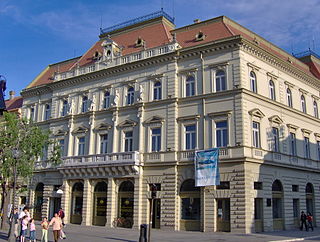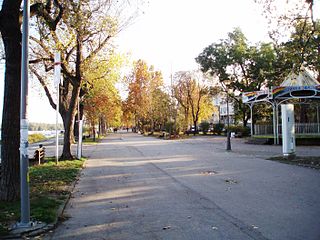
Alexandre Gustave Eiffel was a French civil engineer. A graduate of École Centrale des Arts et Manufactures, he made his name with various bridges for the French railway network, most famously the Garabit Viaduct. He is best known for the world-famous Eiffel Tower, designed by his company and built for the 1889 Universal Exposition in Paris, and his contribution to building the Statue of Liberty in New York. After his retirement from engineering, Eiffel focused on research into meteorology and aerodynamics, making significant contributions in both fields.

Zrenjanin is a city and the administrative center of the Central Banat District in the autonomous province of Vojvodina, Serbia. The city urban area has a population of 67,129 inhabitants, while the city administrative area has 105,722 inhabitants. The old name for Zrenjanin is Veliki Bečkerek or Nagybecskerek as it was known under Austria-Hungary up until 1918. A thousand Catalans founded on 1735 New Barcelona in a place which is now the suburb of Dolja within Zrenjanin, exiled from the War of the Spanish Succession. After World War I and the liberation of Veliki Bečkerek the new name of the city was Petrovgrad, in honor of His Majesty King Peter I the Great Liberator, the King of Serbia and the King of Serbs, Croats and Slovenes.

Elisabeth Bridge is the third newest bridge of Budapest, Hungary, connecting Buda and Pest across the River Danube. The bridge is situated at the narrowest part of the Danube in the Budapest area, spanning only 290 m. It is named after Elisabeth of Bavaria, a popular queen and empress of Austria-Hungary, who was assassinated in 1898. Today, her large bronze statue sits by the bridge's Buda side connection in the middle of a small garden.

Knez Mihailova Street is the main pedestrian and shopping zone in Belgrade, and is protected by law as one of the oldest and most valuable landmarks of the city. Named after Mihailo Obrenović III, Prince of Serbia, it features a number of buildings and mansions built during the late 1870s.

The Republic Square or the Square of the Republic is one of the central town squares and an urban neighborhood of Belgrade, located in the Stari Grad municipality. It is the site of some of Belgrade's most recognizable public buildings, including the National Museum, the National Theatre and the statue of Prince Michael.

Slavija Square is a major commercial junction between the intersections of Kralja Milana, Beogradska, Makenzijeva, Svetosavska, Bulevar oslobođenja, Deligradska and Nemanjina streets in Belgrade. The square was previously named Dimitrije Tucović Square after the prominent Serbian socialist.

Savamala is an urban neighborhood of Belgrade, the capital of Serbia. It is located in Belgrade's municipalities of Savski Venac and Stari Grad.

Finance palace, is a two-floored neo-renaissance palace on the main square in Zrenjanin, Serbia, and one of the most beautiful buildings in the city. The National Museum of Zrenjanin moved into it in 1966 and it is located next to the theatre building.

Cvetni trg or Flower Square is an urban neighborhood of Belgrade, the capital of Serbia. It is located in the Belgrade municipality of Vračar.

Zrenjanin Court House, also known as Palace of Justice is a seat of Municipal, District and Trade Court in Zrenjanin.

The Nikola Pašić Square is one of the central town squares and an urban neighborhoods of Belgrade, the capital of Serbia. The square is named after Nikola Pašić who served as mayor of Belgrade, prime minister of Serbia and prime minister of Yugoslavia. Until 1992 the square was named the Marx and Engels Square.

Old Vojvodina Hotel is a building of the former "Vojvodina" hotel. It is located on the central square, Trg Slobode, in Zrenjanin, Serbia, next to the famous theatre building.

Studentski Trg, or Students Square, is one of the central town squares and an urban neighborhood of Belgrade, the capital of Serbia. It is located in Belgrade's municipality of Stari Grad. In the Classical Antiquity, area of the modern square was the center of Singidunum, Roman precursor of modern Belgrade.

The Cathedral of Saint John of Nepomuk is a Roman Catholic Cathedral in Zrenjanin, Serbia. It is the seat of the Roman Catholic Diocese of Zrenjanin that covers the territory of Serbian Banat. The Cathedral is located in the Zrenjanin's main square, Trg slobode. It is dedicated to Saint John of Nepomuk.
Pančevo Bridge or colloquially Pančevac is a bridge over the Danube in Belgrade, the capital of Serbia. It was named after the northern city of Pančevo which is connected to Belgrade by the road continuing from the bridge. It was the first permanent bridge across the Danube in Belgrade, and until December 2014, when the Pupin Bridge opened further upstream in the municipality of Zemun, the only one.

The Bega or Begej, is a 244 km long river in Romania and Serbia. It rises in the Poiana Ruscă Mountains in Romania, part of the Carpathian Mountains, and it flows into the Tisa river near Titel, Vojvodina, Serbia. Its drainage basin covers an area of 4,458 km2 (1,721 sq mi), of which 2,362 km2 (912 sq mi) in Romania.

Zemunski Kej is an urban neighborhood of Belgrade, the capital of Serbia. It is located in Belgrade's municipality of Zemun.

Carska Bara is the largest individual bog in Serbia, in the municipality of Zrenjanin. Along with the neighboring pond of Stari Begej it forms the Special nature reserve "Carska Bara".

Dry Bridge is a bridge in Zrenjanin, Serbia. It currently does not span any physical obstacle, since the flow of the river under it was diverted.

The Belgrade Main railway station is a former train station in Belgrade, the capital of Serbia. It was built between 1882 and 1885 according to the designs of the architect Dragutin Milutinović, and it has the status of a сultural monument of great importance. Until the opening of the new Belgrade Center station (Prokop) in 2016, it was the city's main station, and the busiest in the country. In order to free up the space for the Belgrade Waterfront project, the station was closed on 1 July 2018, and repurposed to become a museum.






















